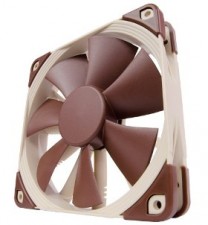Introduction
Fans are all the range in this day and age as we have case fans in all sorts of shapes and sizes and with differing specifications to boot. These products have either been designed for either processor coolers or as a case option. However there has never been a fan product design specifically and targeted at the ‘WATER Cooling’ end of the market. Choosing fans that work well in conjunction with water cooling radiators has been a hit and miss affair as the specifications needed are the reverse of a standard case fan such; as low static pressure ‘case fan’ as opposed to high static pressure for radiators.
One such company that aims to take the guess work out of this are Noctua. A company noted for its high performance CPU coolers with a portfolio that specialises in products that have less noise than many others in the market. This business is very well known for its high quality products and the ‘Marmite’ colour scheme of which is the subject of much discussion amongst the enthusiast crowd. However (and to quote the Marmite saying) love them or hate them; Noctua have certainly made an impact within the silent cooling market.
Company Background
Below is what Noctua have to say about themselves in regards to their company ethos:
In a market that’s increasingly driven by cost saving rather than customer dedication and flooded with branded budget products, we take pride in striving for excellence both in product and service quality. For example, our heatsinks feature all soldered joints for maximum performance and durability, our fans’ 150,000h+ MTBF is backed up by a full 6 years manufacturer’s warranty and when AMD introduced AM2 and Intel introduced LGA1366, we provided thousands of users with mounting kits for free. As a result, an ever growing base of avid Noctua users not only swears by the thoroughgoing premium quality of our products, but also by our excellent, customer-friendly service.
What does Noctua mean?
The little owl, Athene noctua, is the symbol of the Greek goddess Athene, who represents wisdom, science and strategy. She has a marked preference for the most clever among the Greek heroes, like Odysseus, who endure their adventures by the use of savvy consideration instead of mere force. Until today, the owl symbolises intelligence and prudence, its manlike face emblematises attentiveness and communication. We from Noctua follow the suit of its calm and accurate observation in the dark, its soundless flight as well as the effective, economical use of its powers and precise attack.
Let us now move on to the product Specifications
Specifications
Teaming up eleven stator guide vanes with a specially conceived seven blade impeller, the NF-F12’s Focused Flow™ system creates outstanding static pressure and focuses the airflow for superior performance on heatsinks and radiators. At the same time, a wide range of advanced aerodynamic design measures, second generation SSO-Bearings and Noctua’s new, custom designed PWM IC for fully automatic control guarantee astounding quietness of operation. The NF-F12 comes with modular cabling, integrated anti-vibration pads and two speed settings for full flexibility. Its commanding performance, exhaustive set of features and Noctua’s trusted premium quality make it an elite choice for use on air coolers, radiators and other pressure demanding applications.
(http://www.noctua.at/main.php?show=productview&products_id=42&lng=en last accessed 01/03/2012)
 |
What is interesting to note is that Noctua have given a list of the recommended uses for their fan range. For example when using the product as a case cooler or as a radiator fan.
NF-S12B: The NF-S12B has been optimised for “low impedance” applications that don’t require high static pressure and thus combines moderate pressure with outstanding airflow and superb quietness of operation. Choose the NF-S12B for case ventilation, applications with little or no obstruction to airflow as well as all other applications where minimum noise emission has first priority.
NF-P12: The NF-P12 has been designed with more pressure demanding “high impedance” applications in mind. It provides an even balance of high static pressure, high airflow and excellent quietness, which has made it a standard choice for low noise CPU cooling, cases with tight fan grills and other low noise cooling applications with mid- to high airflow resistance.
NF-F12: The NF-F12’s unique Focused Flow™ system produces extremely high static pressure and focuses the airflow in order to achieve even better results on air cooling heatsinks and water cooling radiators. With a top speed of 1500rpm, it also offers more performance headroom for less noise-sensitive applications. Choose the NF-F12 if you’re looking for the best possible performance on heatsinks and radiators.
(http://www.noctua.at/main.php?show=which_fan_is_right_for_me last accessed 01/03/2012)
Let us now move onto the Packaging Section
Packaging
The Noctua box design is of similar to that of previous incarnations, with a small window at the front of the box in order to give a hint on the product that has been purchased! It would have to be noted that the colour scheme of the box, matches that of the fan model itself; with the exception of the inner pages, of which are a brown and black colouring.
Note: since receiving the initial review samples the product packaging has changed somewhat.
 |
 |
 |
 |
Once the box opened you will find various fittings and a specification guide as well as the usual transparent packaging – which holds the various cabling, adapters, four anti-vibration mounts, the screws and of course the NF-F12 fan itself.
 |
 |
 |
 |
Of course we cannot forget the leads which allows the consumer to ‘daisy-chain’ a series of fans together
 |
Lets is now look at the product outside of the packaging shall we?
The Product
One can recognise that the product is from Noctua, due to its ‘Marmite’ colours and sports the and a standard seven blade fan design. The 4-pin cable is very well protected in the usual (Usual from Noctua) rubberised braid. However at first inspection what is different from the previous incarnations is that there are more ‘rubberised’ vibration pads placed at each corner of the fan.
 |
 |
We can certainly see that the air notches are no longer on the blades as in the P12 range but are now placed upon the fan chassis itself. These are the guide vanes that help to generate sound ‘pulses’ along the framework when one of the fan blades crosses over this section.
 |
 |
 |
 |
At last we come to the motor section. Here we have the covering label showing that this is their second generation design in regards to the motor itself.
 |
Below shows the handy little rubber pads at each corner that are held on by two ‘pins’ This is used when a tight seal is needed to be created between fans with the addition to reducing vibration at this key point within the framework.
 |
 |
Let us now move on to the testing procedure.
Methodology
A range of equipment was used to test in order to give an accurate picture of the fans performance. A temperature controlled environment was used with the ambient being 24.3 Degrees-C. Two sensors were placed before and after the radiator. The former being placed just before the fan (blowing air through the radiator) and a second placed just after in order to monitor temperature changes there. Next two in-line sensors were placed within the loop; the first being placed just before the CPU water block in order to monitor fluid in temperatures, The latter to monitor the heat of the fluid coming out of the water block and into radiator. Finally the CPU temperature was measured by using everyone’s favourite program, Realtemp 3.0!
Testing Equipment
- ABIT X48 Tigerforce
- 4 gigabyte of RAM
- Q6600 cpu
- XSPC RASA
- XSPC RES/PUMP 750 COMBO
- ClearFLex 1/2″ ID Tubing
- XSPC RS 240MM
- Lian-Li temperature Monitor (for before and after radiator air temperatures)
- Tagan BZ Piperock 800w PSU for motherboard/CPU/HDD and fans
- Lamptron FC6
Note that the radiator and pump/res were placed OUTSIDE of the chassis, in order to achieve a more accurate reading. It is to be noted that ALL idle temperatures were taken after one hour of 100 percent CPU load by using Prime 95 and then left to cool down for 30 minutes. For the CPU water block a backing plate was used in order to give the EXACT same pressure; thus surface contact between the CPU and water block, in all the tests.
Fans used on the test SYSTEM:
- Noctua NF-P12
- Xilence Red-Wing
- Alpenfohn Wing Boost
- Coolink RS 120MM
Lastly in order to make everything fair (as the Alpenfohn and the Noctua NF-F12 are actually 1500 RPM instead of 1200RPM) we tested all using the slowest performing fan speed of all comparison products Id-Est: 1200 RPM.
Should any reader find that this setup is familiar, then you would be correct as this was used for the Mayhems Pastel and X1 review
 |
 |
 |
 |
http://www.overclockerstech.com/mayhems-pastel-x1-roundup/
Testing
First up are the radiator air in and out on idle and whilst at full capacity.
 |
 |
As we can see with the above images the differences are not noticeable between then fan range. The less efficient a fan is then in theory the higher the radiator out temperature is due to the water and CPU temperatures.
 |
 |
Now here is where it gets very interesting as on Idle the Noctua NF-F12 is the best performing overall ,with the previous incarnation coming second and the Cool Link model being the least performer. However this is all turned on its head when the full load results are examined and that the Cool Link model is overall the best as there is very little difference between the water in and out. The Alpenfohn fan is also a strong contender with the lowest fluids input of all the fans tests here.
Now let us get to those all important CPU Results:
 |
 |
 |
 |
 |
Note: Please be aware that the product is actually the NF-F12 and not the NF-F14 as stated in the charts.
The charts above show that the Noctua NF-F12 is better within a water cooling environment by significant factor than its nearest competitor, sometimes as much as three degrees! It goes to show that the design of the F12 range really does work in the case of the water cooling segment of the market. However on balance all these products are priced cheaper than the Noctua NF-F12; with the nearest would be the Coolink and the Alpenfohn Wing Boost products which are priced at around thirteen pounds sterling.
If we eliminate the previous Noctua Model, and the Xilence Red wing as its priced at around six pounds then this leaves us with three models to test. This would be the Alpenfohn, the Noctua fan in question and finally the CoolinK Link RS120. However the Cool link product has a RPM of only 1200 so in essence this leaves us with the only two products to test for the next stage.
Graphics cards Testing
Here we test the final two products which are the Alpenfohn Wing Boost and the Noctua NF-F12 fan models. These are compared together for the reason that they both operate at 1500 RPM and priced more than the other models
The final test bed is very similar to the previous one except with the use of the following equipment:
- XSPC RX 360MM radiator
- XSPC RAZOR GTX580 water block
- Three of the products mentioned mounted upon the radiator.
As the results show, even when compared ‘like for like’ with the Alpenfohn Wing Boost, the Noctua model simply surges ahead when used in a water cooling based environment.
Even though the other products tested are not exactly in the same price range as the Noctua NF-F12, it still shows that the aforementioned model is suited for a water cooling based situation.
Conclusion
If one listens close the this model and the previous incarnation then the new one is ever so slightly louder. However this is not detectable by everyday use and will not change the overall score of the product. We appreciate the anti vibration pads which are placed at each corner of the fan ID-Est. where the stress and vibration areas are. Alpenfohn Wing Boost, though cheaper than Noctua are still very expensive and is a brilliant model for any enthusiast system. However once again it is a massive undertaking by Noctua to not only to equal the performance of this fan but to trounce it with ease and as such is an achievement in itself!
Once again Noctua have shown that with a creative mind backed up with quality engineering then the NF-F12 it can be placed ahead of the pack.
Now if only we can have fans based upon a different colour-if only as a limited run then everyone will be happy.
Not only is this product great for normal air cooling but by the evidence given above then the Noctua NF-F12 is leagues ahead when using in a water cooling based environment. If the enthusiasts are willing to pay a premium for those extra three degrees then this product should certainly be on their short-list.
We as a water cooling enthusiast Website do not often give gold awards out to fans as the reason for this is that most are optimised for case air intake fans only. However the Noctua NF-F12 seems to ‘fit the bill’ as a fan designed for us water cooling enthusiasts. As a result we give the NF-F12 a 9.1/10 and therefore a gold award.
Pros:
- Fantastic performance in water cooling
- Great ideas on the anti vibration pads at each corner
- Able to link a series of fan by using only one three pin connector
- At around £20 retail
 |
Author (Gilgamesh) Christopher Cressey







 Posted in
Posted in 

